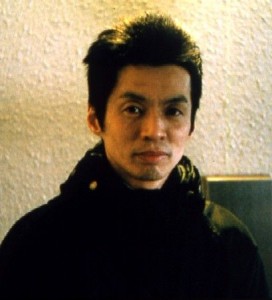ISN’T ANYONE ALIVE?
A BRIEF OVERVIEW OF SOGO “GAKURYU” ISHII’S FILMOGRAPHY
by Ariel Esteban Cayer
 Gakuryu Ishii (formerly known as Sogo Ishii) has always been a notable viagra without prescription sales and complete iconoclast. Making a splash in the late 70s with a series of punk films about showcasing various declinations of teenage rebellion – aptly titled films as Panic High School (1976; reworked as a feature film for Nikkatsu in 1978), Solitude of One Divided by 880,000 (1977) and Charge! Hooligans of Hakata (1978) – Ishii carved himself a definitive place in the cult pantheon with his 1980 post-apocalyptic biker gang film Crazy Thunder Road, which showcased the director’s high-octane style – and subject matters preoccupation – as well as his knack for using music on screen. He would continue in that stylistic vein for many years to come, merging punk rock energy and music with post-apocalyptic or science-fiction narratives in films such as Burst City (which features bands such as The Roosters and The Stalin) or Shuffle, a 16mm which was based on a manga by Akira creator Katsuhiro Otomo
Gakuryu Ishii (formerly known as Sogo Ishii) has always been a notable viagra without prescription sales and complete iconoclast. Making a splash in the late 70s with a series of punk films about showcasing various declinations of teenage rebellion – aptly titled films as Panic High School (1976; reworked as a feature film for Nikkatsu in 1978), Solitude of One Divided by 880,000 (1977) and Charge! Hooligans of Hakata (1978) – Ishii carved himself a definitive place in the cult pantheon with his 1980 post-apocalyptic biker gang film Crazy Thunder Road, which showcased the director’s high-octane style – and subject matters preoccupation – as well as his knack for using music on screen. He would continue in that stylistic vein for many years to come, merging punk rock energy and music with post-apocalyptic or science-fiction narratives in films such as Burst City (which features bands such as The Roosters and The Stalin) or Shuffle, a 16mm which was based on a manga by Akira creator Katsuhiro Otomo
In 1984, Ishii veered if ever so slightly away from cyberpunk music films to make The Crazy Family, a no less abrasive absurdist comedy looking to satirize and subvert the notion of the home and its inherent melodramatic representation in cinema. Following the highly acclaimed film, Ishii would diversify with his 1987 Einstürzende Neubauten concert film/documentary ½ Mensch and his 1989 experimental film The Master of Shiatsu, which Ishii says “was a way to cure [himself], a kind of therapy.”[1].
In the following years, Ishii would touch multiple genres, all the while remaining intensely consistent with themes of dystopia best prices for propecia that had been pervading his cinema until then. The 1994 crime thriller Angel Dust would, while simultaneously being a beautiful portrait of Tokyo, follow a young woman psychic search for a serial killer. His 1995 coming-of-age film August in Water would veer away from the dark, grimy underbelly of contemporary life and instead focus on a slower-paced and seemingly brighter story of a young girl’s supernatural awakening. Tadanobu Asano would work together on the psychological thriller Labyrinth of Dreams (1997) and again on Ishii’s supernatural perio piece Gojoe:Spirit War Chronicle (2000), chronicling the 12th century war between Genji and Heike clans. The following year, Electric Dragon 80.000 V. would see Ishii return to the more aggressive, energy-buzzin’ rock ‘n’ roll territory with an electrifying – literally – superhero film starring Asano and Masatoshi Nagase (of Jarmusch’s Mystery Train fame) and music would also play a big part in his 2003 anthology film Dead End Run. The much more contemplative and serene film Mirrored Mind (2004) would represent a break of form for the director, as well as an indicator of his visual direction moving forward towards Isn’t Anyone Alive?, the director’s first full feature-length film since Gojoe.
In 2010, Ishii, known until that point as Sogo Ishii, decided to change his given name to Gakuryu – the characters of Gaku (mountain) and ryu (dragon) giving him the name for his new production company, Dragon Mountain. Which brings us to Isn’t Anyone Alive?, perhaps one of the most surprisingly unconventional films in the director’s filmography, an avant-garde, theater-based experiment about post-apocalyptic narratives in which every singly protagonist…dies.
With sharp, unconventional dialogue, Isn’t Anyone Alive? adapts the Shiro Maeda play of the same name in a darkly humorous and experimental film that is utterly and simplistically absurd in its premise – that had me thinking of Samuel Beckett’s Waiting for Godot at times! – yet completely fascinating: set against the backdrop of an urban legend, students on a University campus lowest cost levitra no prescription canada start dropping like flies at different rates, most while in the midst of solving some pressing interpersonal issues. But what do those issues – or anything, for that matter – mean, when death is so imminent?
Furthermore, Ishii proves here that he hasn’t lost his knack for musical intervention, punctuating every scene with a disturbing, eerie and fitting sonic blast. Nihilistic outlook at life or absurd take on mortality, Isn’t Anyone Alive? is not to be missed, having its Canadian premiere on July 31st in the J.A. de Seve theater at 9h45pm and playing again on August 3rd at 3h20pm.

 July 31, 2012
July 31, 2012  No Comments
No Comments










